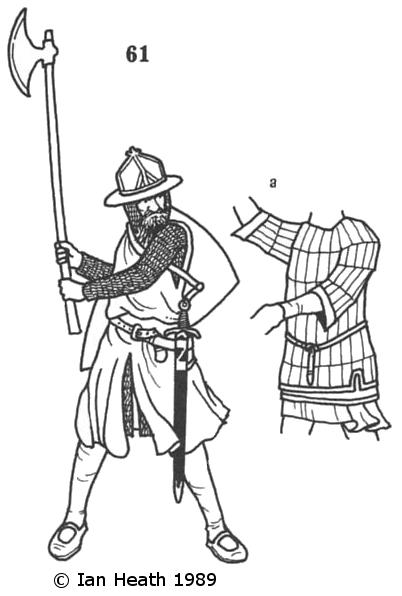
Register a SNAP EBT card with Amazon
SCANDINAVIAN HIRDMAN, 13th CENTURY
An extract from Armies of Feudal Europe 1066-1300by Ian Heath
61. SCANDINAVIAN HIRDMAN, 13th CENTURY
The 'Speculum Regale' records the best armour for a warrior fighting on foot to be only a thick gambeson of soft linen 'thoroughly blackened', a strong shield or buckler and a heavy sword, for ship-board fighting adding a mail hauberk, a long spear and a hangadi stalhufa (a 'hanging steel hat'), which term describes either a kettle-helmet or possibly one like that worn by figure 55. However, even in the 12th century equipment such as that depicted here can be found described in written sources, which was typical of that worn by hirdmen and other household troops by the 13th century at the latest. It should also be noted that lamellar armour continued to be worn by some Scandinavians throughout this period, specifically by the Swedes (doubtless as a result of their trading links with Russia and Central Asia); 61a depicts a lamellar corselet from a 12th century altar front at Broddestorp Church, Vastergotland, Sweden.
The kettle-helmet, usually described in the sagas as a vida stalhufa ('wide steel hat'), was particularly popular in Scandinavia, remaining in common use from the 13th century to the 15th. The infamous axe of the Viking age also remained popular, though it had increased somewhat in length since the 11th century. A large number of English and Scandinavian mss. of the 12th-14th centuries show such axes with hafts up to 6 feet in length, and it is probably such weapons which the Icelandic sagas refer to as halberds (see note to figure 38). Other principal weapons were spears, swords and bows.
Shields seem to have been painted mainly red as they had been in Viking times - Giraldus Cambrensis records the Scandinavians at Dublin in 1171 as having round, red shields, for example, while they are often depicted or described as red in frescoes, ms. illustrations and sagas. A contemporary poem describing the Battle of Largs (1263) even calls the Norse soldiers 'red shields'
Altar from Broddetorp Parish Church, 12th century, Västergötland, Sweden
'Massacre of the Innocents', Dädesjö Church ceiling paintings, Småland, Sweden, late 13th century
Illuminations from the collection of Icelandic sagas, the Flateyjarbók
Topography of Ireland by Giraldus Cambrensis translated by Thomas Forester
Illuminations from the Topographia Hibernica and Expugnatio Hibernica by Giraldus Cambrensis
Next: 62. SCANDINAVIAN MILITIAMAN, 12th CENTURY in Armies of Feudal Europe 1066-1300, by Ian Heath

